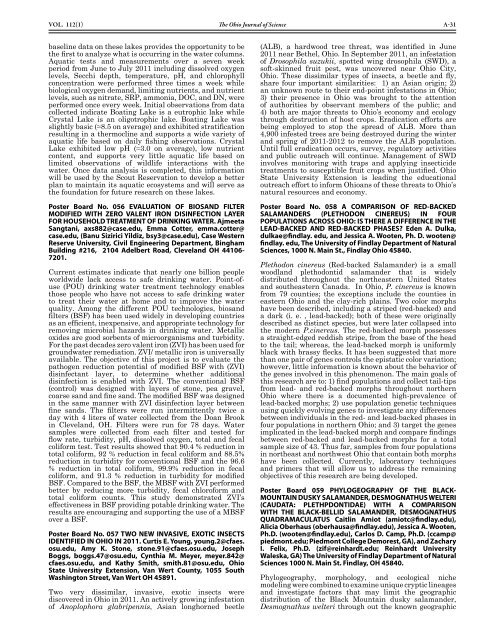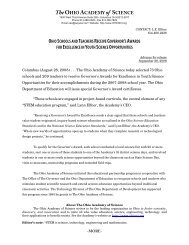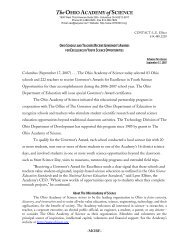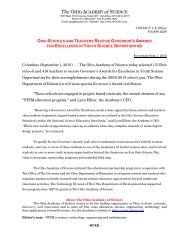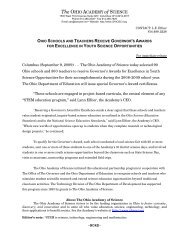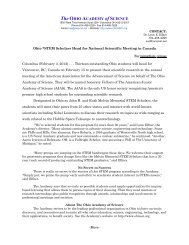The Ohio Journal of - The Ohio Academy of Science
The Ohio Journal of - The Ohio Academy of Science
The Ohio Journal of - The Ohio Academy of Science
You also want an ePaper? Increase the reach of your titles
YUMPU automatically turns print PDFs into web optimized ePapers that Google loves.
Vol. 112(1)<br />
baseline data on these lakes provides the opportunity to be<br />
the first to analyze what is occurring in the water columns.<br />
Aquatic tests and measurements over a seven week<br />
period from June to July 2011 including dissolved oxygen<br />
levels, Secchi depth, temperature, pH, and chlorophyll<br />
concentration were performed three times a week while<br />
biological oxygen demand, limiting nutrients, and nutrient<br />
levels, such as nitrate, SRP, ammonia, DOC, and DN, were<br />
performed once every week. Initial observations from data<br />
collected indicate Boating Lake is a eutrophic lake while<br />
Crystal Lake is an oligotrophic lake. Boating Lake was<br />
slightly basic (≈8.5 on average) and exhibited stratification<br />
resulting in a thermocline and supports a wide variety <strong>of</strong><br />
aquatic life based on daily fishing observations. Crystal<br />
Lake exhibited low pH (≈3.0 on average), low nutrient<br />
content, and supports very little aquatic life based on<br />
limited observations <strong>of</strong> wildlife interactions with the<br />
water. Once data analysis is completed, this information<br />
will be used by the Scout Reservation to develop a better<br />
plan to maintain its aquatic ecosystems and will serve as<br />
the foundation for future research on these lakes.<br />
Poster Board No. 056 EVALUATION OF BIOSAND FILTER<br />
MODIFIED WITH zERO VALENT IRON DISINFECTION LAYER<br />
FOR HOUSEHOLD TREATMENT OF DRINKING WATER. Ajmeeta<br />
Sangtani, axs882@case.edu, Emma Cotter, emma.cotter@<br />
case.edu, (Banu Sizirici Yildiz, bsy3@case.edu), Case Western<br />
Reserve University, Civil Engineering Department, Bingham<br />
Building #216, 2104 Adelbert Road, Cleveland OH 44106-<br />
7201.<br />
Current estimates indicate that nearly one billion people<br />
worldwide lack access to safe drinking water. Point-<strong>of</strong>use<br />
(POU) drinking water treatment technology enables<br />
those people who have not access to safe drinking water<br />
to treat their water at home and to improve the water<br />
quality. Among the different POU technologies, biosand<br />
filters (BSF) has been used widely in developing countries<br />
as an efficient, inexpensive, and appropriate technology for<br />
removing microbial hazards in drinking water. Metallic<br />
oxides are good sorbents <strong>of</strong> microorganisms and turbidity.<br />
For the past decades zero valent iron (ZVI) has been used for<br />
groundwater remediation. ZVI/ metallic iron is universally<br />
available. <strong>The</strong> objective <strong>of</strong> this project is to evaluate the<br />
pathogen reduction potential <strong>of</strong> modified BSF with (ZVI)<br />
disinfectant layer, to determine whether additional<br />
disinfection is enabled with ZVI. <strong>The</strong> conventional BSF<br />
(control) was designed with layers <strong>of</strong> stone, pea gravel,<br />
coarse sand and fine sand. <strong>The</strong> modified BSF was designed<br />
in the same manner with ZVI disinfection layer between<br />
fine sands. <strong>The</strong> filters were run intermittently twice a<br />
day with 4 liters <strong>of</strong> water collected from the Doan Brook<br />
in Cleveland, OH. Filters were run for 78 days. Water<br />
samples were collected from each filter and tested for<br />
flow rate, turbidity, pH, dissolved oxygen, total and fecal<br />
coliform test. Test results showed that 90.4 % reduction in<br />
total coliform, 92 % reduction in fecal coliform and 88.5%<br />
reduction in turbidity for conventional BSF and the 96.6<br />
% reduction in total coliform, 99.9% reduction in fecal<br />
coliform, and 91.3 % reduction in turbidity for modified<br />
BSF. Compared to the BSF, the MBSF with ZVI performed<br />
better by reducing more turbidity, fecal chlor<strong>of</strong>orm and<br />
total coliform counts. This study demonstrated ZVI’s<br />
effectiveness in BSF providing potable drinking water. <strong>The</strong><br />
results are encouraging and supporting the use <strong>of</strong> a MBSF<br />
over a BSF.<br />
Poster Board No. 057 TWO NEW INVASIVE, EXOTIC INSECTS<br />
IDENTIFIED IN OHIO IN 2011. Curtis E. Young, young.2@cfaes.<br />
osu.edu, Amy K. Stone, stone.91@cfaes.osu.edu, Joseph<br />
Boggs, boggs.47@osu.edu, Cynthia M. Meyer, meyer.842@<br />
cfaes.osu.edu, and Kathy Smith, smith.81@osu.edu, <strong>Ohio</strong><br />
State University Extension, Van Wert County, 1055 South<br />
Washington Street, Van Wert OH 45891.<br />
Two very dissimilar, invasive, exotic insects were<br />
discovered in <strong>Ohio</strong> in 2011. An actively growing infestation<br />
<strong>of</strong> Anoplophora glabripennis, Asian longhorned beetle<br />
<strong>The</strong> <strong>Ohio</strong> <strong>Journal</strong> <strong>of</strong> <strong>Science</strong> A-31<br />
(ALB), a hardwood tree threat, was identified in June<br />
2011 near Bethel, <strong>Ohio</strong>. In September 2011, an infestation<br />
<strong>of</strong> Drosophila suzukii, spotted wing drosophila (SWD), a<br />
s<strong>of</strong>t-skinned fruit pest, was uncovered near <strong>Ohio</strong> City,<br />
<strong>Ohio</strong>. <strong>The</strong>se dissimilar types <strong>of</strong> insects, a beetle and fly,<br />
share four important similarities: 1) an Asian origin; 2)<br />
an unknown route to their end-point infestations in <strong>Ohio</strong>;<br />
3) their presence in <strong>Ohio</strong> was brought to the attention<br />
<strong>of</strong> authorities by observant members <strong>of</strong> the public; and<br />
4) both are major threats to <strong>Ohio</strong>’s economy and ecology<br />
through destruction <strong>of</strong> host crops. Eradication efforts are<br />
being employed to stop the spread <strong>of</strong> ALB. More than<br />
4,900 infested trees are being destroyed during the winter<br />
and spring <strong>of</strong> 2011-2012 to remove the ALB population.<br />
Until full eradication occurs, survey, regulatory activities<br />
and public outreach will continue. Management <strong>of</strong> SWD<br />
involves monitoring with traps and applying insecticide<br />
treatments to susceptible fruit crops when justified. <strong>Ohio</strong><br />
State University Extension is leading the educational<br />
outreach effort to inform <strong>Ohio</strong>ans <strong>of</strong> these threats to <strong>Ohio</strong>’s<br />
natural resources and economy.<br />
Poster Board No. 058 A COMPARISON OF RED-BACKED<br />
SALAMANDERS (PLETHODON CINEREUS) IN FOUR<br />
POPULATIONS ACROSS OHIO: IS THERE A DIFFERENCE IN THE<br />
LEAD-BACKED AND RED-BACKED PHASES? Eden A. Dulka,<br />
dulkae@findlay. edu, and Jessica A. Wooten, Ph. D. wooten@<br />
findlay. edu, <strong>The</strong> University <strong>of</strong> Findlay Department <strong>of</strong> Natural<br />
<strong>Science</strong>s, 1000 N. Main St., Findlay <strong>Ohio</strong> 45840.<br />
Plethodon cinereus (Red-backed Salamander) is a small<br />
woodland plethodontid salamander that is widely<br />
distributed throughout the northeastern United States<br />
and southeastern Canada. In <strong>Ohio</strong>, P. cinereus is known<br />
from 79 counties; the exceptions include the counties in<br />
eastern <strong>Ohio</strong> and the clay-rich plains. Two color morphs<br />
have been described, including a striped (red-backed) and<br />
a dark (i. e. , lead-backed); both <strong>of</strong> these were originally<br />
described as distinct species, but were later collapsed into<br />
the modern P.cinereus. <strong>The</strong> red-backed morph possesses<br />
a straight-edged reddish stripe, from the base <strong>of</strong> the head<br />
to the tail; whereas, the lead-backed morph is uniformly<br />
black with brassy flecks. It has been suggested that more<br />
than one pair <strong>of</strong> genes controls the epistatic color variation;<br />
however, little information is known about the behavior <strong>of</strong><br />
the genes involved in this phenomenon. <strong>The</strong> main goals <strong>of</strong><br />
this research are to: 1) find populations and collect tail-tips<br />
from lead- and red-backed morphs throughout northern<br />
<strong>Ohio</strong> where there is a documented high-prevalence <strong>of</strong><br />
lead-backed morphs; 2) use population genetic techniques<br />
using quickly evolving genes to investigate any differences<br />
between individuals in the red- and lead-backed phases in<br />
four populations in northern <strong>Ohio</strong>; and 3) target the genes<br />
implicated in the lead-backed morph and compare findings<br />
between red-backed and lead-backed morphs for a total<br />
sample size <strong>of</strong> 43. Thus far, samples from four populations<br />
in northeast and northwest <strong>Ohio</strong> that contain both morphs<br />
have been collected. Currently, laboratory techniques<br />
and primers that will allow us to address the remaining<br />
objectives <strong>of</strong> this research are being developed.<br />
Poster Board 059 PHYLOGEOGRAPHY OF THE BLACK-<br />
MOUNTAIN DUSKY SALAMANDER, DESMOGNATHUS WELTERI<br />
(CAUDATA: PLETHPDONTIDAE) WITH A COMPARISON<br />
WITH THE BLACK-BELLID SALAMANDER, DESMOGNATHUS<br />
QUADRAMACULATUS Caitlin Amiot (amiotc@findlay.edu),<br />
Alicia Oberhaus (oberhausa@findlay.edu), Jessica A. Wooten,<br />
Ph.D. (wooten@findlay.edu), Carlos D. Camp, Ph.D. (ccamp@<br />
piedmont.edu; Piedmont College Demorest, GA), and zachary<br />
I. Felix, Ph.D. (zif@reinhardt.edu; Reinhardt University<br />
Waleska, GA) <strong>The</strong> University <strong>of</strong> Findlay Department <strong>of</strong> Natural<br />
<strong>Science</strong>s 1000 N. Main St. Findlay, OH 45840.<br />
Phylogeography, morphology, and ecological niche<br />
modeling were combined to examine unique cryptic lineages<br />
and investigate factors that may limit the geographic<br />
distribution <strong>of</strong> the Black Mountain dusky salamander,<br />
Desmognathus welteri through out the known geographic


